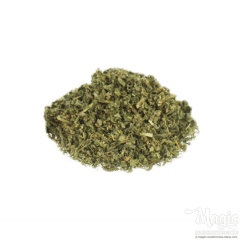Catmint: More Than Just a Feline Delight
Posted under: How to's, Our products

Catmint,Nepeta cataria , also known as catnip and catswort, is a perennial herb that is part of the mint family. While it’s famous for its effects on cats, it has been used for thousands of years by humans for its potential healing properties. In this blog post, we’ll explore the how to use and grow catmint. We include botany, history, and effects of catnip on both cats and humans.
Botany
Catmint (Nepeta cataria) is a perennial plant that can reach a height of 50-100 cm and a similar width. It has wide-based leaves that taper into a point and small flowers that bloom during the flowering period, which feature beautiful hues of pink and white with delicate purple spots. It primarily grows in forests and meadows in Europe, Asia, and Africa, but it has also been naturalized in North America.
Catnip thrives best with full sun exposure and warm temperatures, but it is winter-hardy and requires little attention during the colder months. It typically flowers from July to September, and the seeds should be sown between mid-March and mid-May.
History of Catmint
Catmint, also known as catnip, has a long history of use as a medicinal herb. While it is mostly known today for its effects on cats, it has been used by humans for thousands of years as a stimulant, particularly in traditional European medicine.
The ancient Romans were among the first to use catmint as a medicine, using it as a natural remedy for fever, stomach aches, nervous headaches, rheumatism, insomnia, menstrual cramps, and hysteria. The plant was also used as a diaphoretic, which means it promotes sweating without increasing the heat of the body system, and as a relaxant.
In the Middle Ages, catmint was believed to ward off evil spirits and was used in amulets and charms. It was also used as a culinary herb, flavoring soups and stews, and as a natural insect repellent. During this time, it was also used as a stimulant, and it was believed to improve concentration and focus.
During the 18th and 19th centuries, catmint became a popular herb in traditional European medicine, particularly in England. It was used as a stimulant and as a natural remedy for colds, headaches, and other ailments. In America, it was used in the same way, with the first recorded use of catmint in the United States being a recipe for a food dish that included catnip as an ingredient in Massachusetts in 1712.
In addition to its use as a stimulant and medicinal herb, catmint has also been used as a flavoring in various alcoholic beverages, including beer and wine. In the late 19th and early 20th centuries, it was also used as an ingredient in certain smoking blends, believed to produce a calming and relaxing effect.
Effects of Catnip
When it comes to cats, catnip is primarily given to add some excitement to their lives. After consuming the herb, cats experience a wave of euphoria, with some rolling around in bliss, others becoming playful, and others becoming calm and relaxed.
While catnip does not affect humans in the same way it affects cats, it still has potential benefits. For example, it may aid in achieving a restful night's sleep and support digestion due to its soothing effect. People who use catnip regularly have reported a variety of other benefits, but more research is needed on this topic.
Altered states
In a high dose, catmint can have more potent effects than those seen in lower doses. While catmint is primarily known for its relaxing effects, it can also be mildly hallucinogenic in higher doses. Some people have reported experiencing an altered state of consciousness, euphoria, and a heightened sense of imagination after consuming large amounts of catmint.
The Erowid describes the effects of catnip in more detail. In low to moderate doses, catnip is said to have a calming and sedative effect on humans, helping to reduce anxiety and promote sleep. In higher doses, catnip can cause mild hallucinations, although these effects are usually not as strong as those produced by more potent psychoactive substances like LSD or psilocybin mushrooms.
It's important to note that the effects of catmint can vary depending on the individual and the dose taken. Not everyone may experience these more intense effects, and it's always recommended to start with a low dose and gradually increase it as needed.
How to grow Catmint from seeds?
Growing catmint from seeds is relatively easy, and the plant is quite hardy. Here's a step-by-step guide on how to grow catmint from seeds:
- Choose a sunny spot: Catmint thrives in full sun and well-draining soil. Choose a sunny spot in your garden that receives at least six hours of direct sunlight daily.
- Prepare the soil: Catmint prefers nutrient-rich, loose soil. If your soil is heavy, add some sand or perlite to improve drainage. You can also mix in some compost to improve the soil's fertility.
- Sow the seeds: Sow the seeds in early spring, about 2-4 weeks before the last frost date. Scatter the seeds on the soil surface and lightly cover them with a thin layer of soil. Space the seeds about 18-24 inches apart.
- Water the seeds: Water the seeds gently to avoid washing them away. Keep the soil moist but not waterlogged until the seeds germinate. This usually takes about 10-14 days.
- Thin the seedlings: Once the seedlings are about 2-3 inches tall, thin them out to about 18-24 inches apart. This will give each plant enough space to grow and spread.
- Transplant the seedlings: If you started your seeds indoors, transplant the seedlings outdoors when they are about 4-6 inches tall. Make sure to harden off the seedlings first by gradually exposing them to outdoor conditions over a period of 1-2 weeks.
- Care for the plants: Catmint requires little care once established. Water the plants deeply once a week during hot and dry weather. Deadhead the flowers regularly to encourage more blooms. Cut back the plants in late summer to promote a second flush of blooms in the fall.
Growing catmint from seeds is a simple and rewarding process. With a little patience and care, you can enjoy the beautiful blooms and relaxing aroma of this versatile herb in your garden.
Conclusion
Catnip may be famous for its effects on cats, but it has a long history of use by humans as well. While it’s fun to watch cats enjoy the effects of this seemingly psychoactive herb, there is much more to this plant species than feline entertainment. As research continues, we may discover even more potential benefits of catnip for both cats and humans.


March 3, 2023